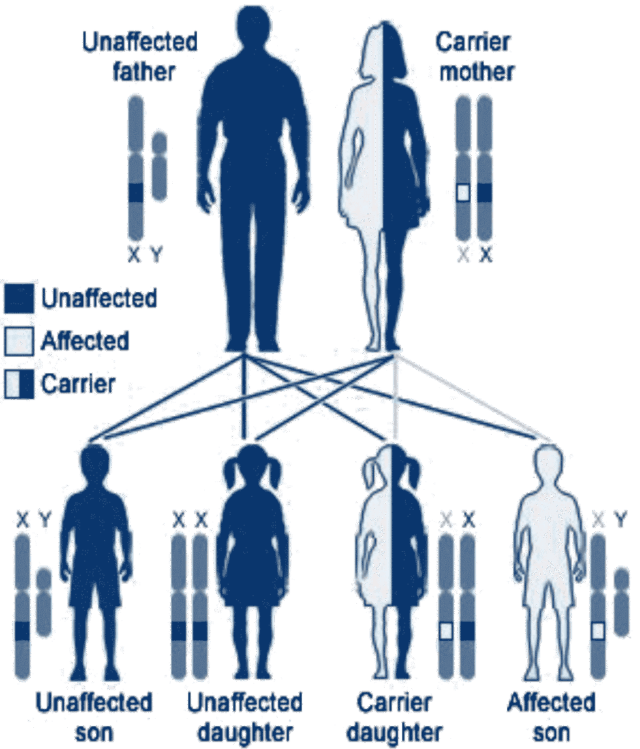Hoy se está hablando mucho de la terapia génica, que ofrece el potencial de toda una gama nueva de tratamientos avanzados para un gran número de trastornos médicos y remedios a muchas enfermedades, habiéndose alcanzado exitosos resultados en ciertos campos, a la vez que decepcionantes fracasos en otros. El propósito de este prospecto es el de esbozar de qué forma quienes padecen del síndrome linfoproliferativo ligado al cromosoma X (XLP) podrían beneficiarse potencialmente de esta ciencia emergente, y cómo podría funcionar en concreto para el XLP.

The inheritance of XLP-1 follows an “X-linked” (or “sex-linked”) recessive pattern, in which females can be carriers of a SH2DIA mutation but only males will have the disease. Because females have two copies of the X-chromosome, they also have two copies of every gene on the X-chromosome. Because SH2DIA mutations are very rare, a female who inherits one chromosome carrying a mutation of the gene for XLP from one parent will almost always inherit a normal X-chromosome from the other parent. In all XLP-1 mothers who carry a SH2DIA mutation on one of their two X-chromosomes, the normal SH2DIA gene on the other X chromosome provides enough SH2DIA function to prevent any disease. For this reason, a SH2DIA mutation in a female is termed a “recessive” mutation. In other words, although the female who carries a recessive SH2DIA mutation can pass the abnormal SH2DIA gene on to her children, she will not show any symptoms of XLP because of the protective effect of the normal SH2DIA gene on the other X-chromosome.
Unlike females who carry two copies of SH2DIA on their matched X-chromosomes, males have only one copy of the SH2DIA gene because they have only one X-chromosome. This is because a male who inherits from his mother an X-chromosome with one SH2DIA gene inherits from his father a shorter Y chromosome that lacks a copy of the SH2DIA gene. With no normal SH2DIA gene on the Y-chromosome to compensate for a SH2DIA mutation inherited on the mother’s X-chromosome, all males with a SH2DIA mutation will have clinical signs of XLP.
When a mother is a carrier of a SH2DIA mutation on one of her two X-chromosomes, there is a 50% chance in any pregnancy that she will pass the X-chromosome with the SH2DIA mutation onto the child. If the child who inherits the SH2DIA mutation is a girl, she will be a carrier of XLP-1, and, like her mother, be able to pass the SH2DIA mutation on to her own children. However, also like her mother, she will not show symptoms of XLP. If the child is a boy, there is a 50% chance he will inherit SH2DIA mutation and have XLP-1 and a 50% chance he will inherit only the X chromosome with the normal SH2DIA gene and, therefore, not have XLP. If the male inherits the SH2DIA mutation and has XLP, all of his daughters will be carriers, but none of his sons will have XLP. This is because the X- and Y-chromosomes are the sex-determining chromosomes, and all children who inherit his Y-chromosome (with no SH2DIA gene) from him will be boys, and all children who inherit the X-chromosome with a SH2DIA mutation will be girls. A genetic counsellor can assist families in understanding these potential outcomes.
When a SH2DIA mutation for XLP cannot be detected in either parent, this is considered a new mutation or possibly a different form of XLP such as XLP-2 (where the defective or missing gene is XIAP. New mutations can be sporadic or they can be a result of “gonadal mosaicism.” Gonadal mosaicism is the rare occurrence of a genetic mutation in a proportion of the eggs or sperm of an individual as a result of a random mutation that occurs during the development of eggs and sperm. The individual does not have any signs of the disorder, and the mutation would not be detected by a blood test because it is in only the egg or sperm cells. However, if one of the egg or sperm cells is used to conceive a child, that child will have the mutation in all cells.
Published April 2009.
La presente información tiene únicamente fines divulgativos y no de consulta médica, por lo que no deberá usarse para diagnosticar o tratar cuestiones relativas a la salud ni enfermedades, puesto que no es un sustituto de la debida atención profesional.